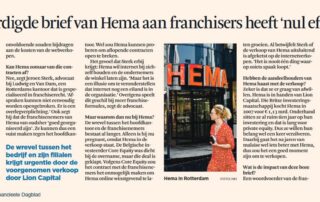Franchise agreements and horizontal cooperation
Franchise agreements are, by their nature, so-called vertical in nature. This means that there is a vertical cooperation between the franchisor, the one who makes the franchise formula available, and the franchisee, the one who exercises the franchise formula. This is generally seen as a collaboration between two different links in the supply chain.
In addition, we know of cooperation between competitors in practice. We call this horizontal cooperation. In terms of competition law, considerably less is allowed within a horizontal collaboration than in a vertical collaboration, based on regular franchise agreements. On the basis of a common franchise agreement, it is permitted to stipulate matters such as exclusive purchasing, price recommendation arrangements, non-competition clauses, etc. between franchisor and franchisee. All these arrangements are not or hardly permitted in the case of cooperation between competitors. In the case of a collaboration between competitors, one should think of a partnership of, for example, two or more greengrocers who jointly make agreements with regard to the subjects mentioned above. If these agreements take place on a joint, for example cooperative basis, the legislator only allows such cooperation to a very limited extent. This is completely different with a franchise relationship. The topics mentioned here can indeed be properly constructed on the basis of a franchise agreement between franchisor and franchisee. In practice, of course, there must actually be a vertical relationship: cooperation between competitors may not lead to an artificial franchise construction with the aim of stipulating vertically what is actually not possible horizontally.
When setting up a franchise construction, the parties are advised to carefully check in advance whether there is cooperation between the parties or whether there is a franchise concept actually made available by a franchisor. If the latter is the case, the way is open for a construction that is permissible under competition law, based on a common franchise agreement.
Ludwig & Van Dam franchise attorneys, franchise legal advice

Other messages
Late notification that no franchise agreement will be concluded
On April 11, 2017, EQLI:NL:GHARL:2017:3104, the Amsterdam-Leeuwarden Court of Appeal not only assessed the question of whether the negotiations on a franchise agreement to be concluded
Want to get rid of your franchise agreement in the meantime?
Franchise agreements are usually concluded for a longer period of time. How do you break open a franchise agreement?
HEMA in conflict with franchisees about e-commerce agreements
On 18 July 2018, the District Court of Amsterdam, ECLI:NL:RBAMS:2018:5098, rendered a judgment in proceedings on the merits in which the franchisees were largely ruled in favor of e-commerce.
mr. J. Sterk about HEMA conflict in the FD 18 July 2018
mr. J. Sterk about HEMA conflict in the FD.
Column Franchise+ – “Legal Franchise Statistics 2018”
The Legal Franchise Statistics have been compiled for 10 years by Ludwig & Van Dam attorneys on the basis of all published judgments of judges.
Franchisor prohibits opening (franchise) company
A franchisor applied for interim measures to prohibit a franchisee from opening a franchisee's business.






